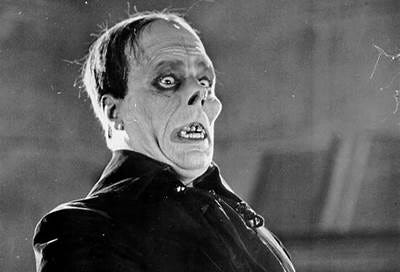Lon Chaney as Erik, the phantom of the Opera, in the silent movie version.
This extract, the sixth, from OFF-BEAT WALKS AROUND PARIS, to be published by Museyon shortly, is reserved for paying subscribers. The following, on the Opera building itself , is one of the book’s many additional notes.
ABOUT THE OPERA GARNIER.
As Napoleon III intended, the building of a new Opera house attracted enterprises to the area chosen for its construction. Hotels, theaters and such department stores as Galeries Lafayette and Au Printemps seized whole blocks of nearby Boulevard Haussmann, using the swirls and curlicues of art nouveau to create cathedrals of commerce. Galeries Lafayette’s domed roof of glass and iron was so strong that the store offered 25,000 francs to the first aircraft to land on it. They took the roof down during World War I, for fear it might be smashed by German bombing, but once it was reassembled, daredevil aviator Jules Védrines succeeded on January 19, 1919, at the cost of wrecking his plane and injuring himself.
https://www.ina.fr/ina-eclaire-actu/jules-vedrines-un-pilote-sur-les-galeries-lafayette
In 1875, the Opéra de Paris was the last word in construction. Garnier, realizing that the water table under his site was only a few meters below the surface, laid a concrete “raft” or caisson to block any water welling up. Throughout the 13 years it took to complete the foundations, steam pumps operated around the clock to keep them dry.
In 1871, the anarchist uprising known as the Paris Commune convulsed Paris. The police, overwhelmed with the volume of prisoners, held some in cellars under the Opéra site. Among the journalists covering their trial was Gaston Leroux. Already an author of crime stories, he saw the possibilities of a mystery set in the building, but, more importantly, beneath it. Garnier’s problems with water seepage gave him the image of a subterranean lake, across which a cloaked and masked figure poled himself. For his plot, he pirated Beauty and the Beast, and reached back to such Gothic novels of the previous century as The Castle of Otranto and The Mysteries of Udolpho, in which helpless females were imprisoned under apparently haunted castles. Out of these emerged the story of disfigured composer Erik who knows the Opéra well enough to secretly move around and under it, materializing in dressing rooms and private boxes, and even appearing in costume at a masked ball as Edgar Allan Poe’s Red Death.
The rest of the world discovered Leroux’s story through the 1925 film starring Lon Chaney, who screwed metal rings into his eye sockets to create a spectral stare and wired back his nose to suggest a skull from which the flesh had been burned. So vivid was his performance that the existence of the lake was assumed. Some water did enter the foundations once the pumps were turned off, but only in one space, and then shallow enough for a man to stand upright. According to the Opéra’s current historian, “the pressure of the water in the tank stops any more rising up through the foundations, and the weight of the tank stabilizes the building.” Today, this cistern, inaccessible except through a grating, is visited only by fire-fighters to practice using underwater breathing apparatus in the dark. The sole permanent residents are catfish, blind and white.
Keep reading with a 7-day free trial
Subscribe to Aussie On the Metro to keep reading this post and get 7 days of free access to the full post archives.




